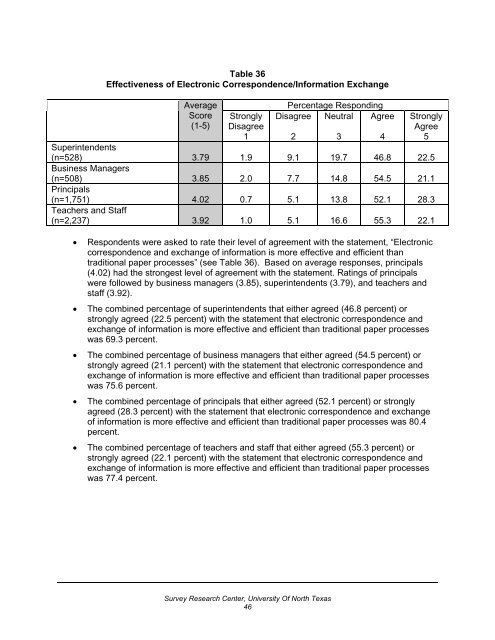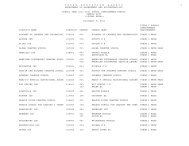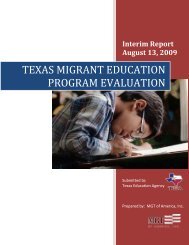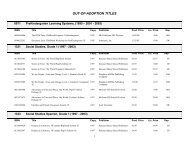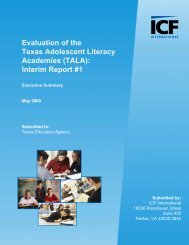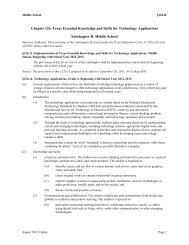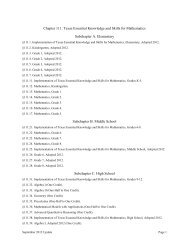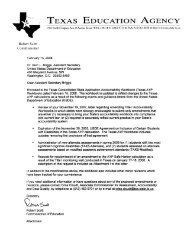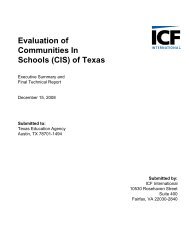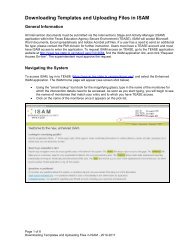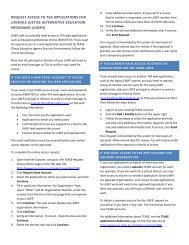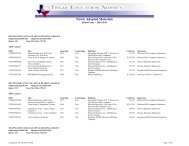2004 Customer Satisfaction Survey (PDF, 566 KB) - TEA - Home ...
2004 Customer Satisfaction Survey (PDF, 566 KB) - TEA - Home ...
2004 Customer Satisfaction Survey (PDF, 566 KB) - TEA - Home ...
Create successful ePaper yourself
Turn your PDF publications into a flip-book with our unique Google optimized e-Paper software.
Table 36<br />
Effectiveness of Electronic Correspondence/Information Exchange<br />
Average<br />
Score<br />
(1-5)<br />
Strongly<br />
Disagree<br />
1<br />
Percentage Responding<br />
Disagree Neutral Agree<br />
Strongly<br />
Agree<br />
5<br />
2 3 4<br />
Superintendents<br />
(n=528) 3.79 1.9 9.1 19.7 46.8 22.5<br />
Business Managers<br />
(n=508) 3.85 2.0 7.7 14.8 54.5 21.1<br />
Principals<br />
(n=1,751) 4.02 0.7 5.1 13.8 52.1 28.3<br />
Teachers and Staff<br />
(n=2,237) 3.92 1.0 5.1 16.6 55.3 22.1<br />
• Respondents were asked to rate their level of agreement with the statement, “Electronic<br />
correspondence and exchange of information is more effective and efficient than<br />
traditional paper processes” (see Table 36). Based on average responses, principals<br />
(4.02) had the strongest level of agreement with the statement. Ratings of principals<br />
were followed by business managers (3.85), superintendents (3.79), and teachers and<br />
staff (3.92).<br />
• The combined percentage of superintendents that either agreed (46.8 percent) or<br />
strongly agreed (22.5 percent) with the statement that electronic correspondence and<br />
exchange of information is more effective and efficient than traditional paper processes<br />
was 69.3 percent.<br />
• The combined percentage of business managers that either agreed (54.5 percent) or<br />
strongly agreed (21.1 percent) with the statement that electronic correspondence and<br />
exchange of information is more effective and efficient than traditional paper processes<br />
was 75.6 percent.<br />
• The combined percentage of principals that either agreed (52.1 percent) or strongly<br />
agreed (28.3 percent) with the statement that electronic correspondence and exchange<br />
of information is more effective and efficient than traditional paper processes was 80.4<br />
percent.<br />
• The combined percentage of teachers and staff that either agreed (55.3 percent) or<br />
strongly agreed (22.1 percent) with the statement that electronic correspondence and<br />
exchange of information is more effective and efficient than traditional paper processes<br />
was 77.4 percent.<br />
<strong>Survey</strong> Research Center, University Of North Texas<br />
46


